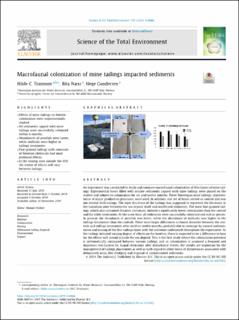| dc.contributor.author | Trannum, Hilde Cecilie | |
| dc.contributor.author | Næss, Rita | |
| dc.contributor.author | Gundersen, Hege | |
| dc.date.accessioned | 2020-08-17T11:40:16Z | |
| dc.date.available | 2020-08-17T11:40:16Z | |
| dc.date.created | 2020-08-03T16:37:03Z | |
| dc.date.issued | 2020 | |
| dc.identifier.citation | Trannum, H. C., Næss, R. & Gundersen, H. (2020). Macrofaunal colonization of mine tailings impacted sediments. Science of the Total Environment, 708. doi: | en_US |
| dc.identifier.issn | 1879-1026 | |
| dc.identifier.uri | https://hdl.handle.net/11250/2672619 | |
| dc.description.abstract | An experiment was conducted to study and compare macrofaunal colonization of thin layers of mine tailings. Experimental boxes filled with marine sediments capped with mine tailings were placed on the seabed and subject to colonization for six and twelve months. Three Norwegian mine tailings, representative of major production processes, were used. In addition, one set of boxes served as control and was not treated with tailings. The layer thickness of the tailings was supposed to represent the thickness in the transition zone between the sea deposit itself and unaffected sediments. The most fine-grained tailings, which also contained flotation chemicals, showed a significantly lower colonization than the control and the other treatments. At the same time, all sediments were successfully colonized and rich in species. In general, the abundance of annelids was lower, while the abundance of mollusks was higher in the tailings-treatments than the controls. There were larger differences in faunal densities between the controls and tailings-treatments after six than twelve months, probably due to coverage by natural sedimentation and mixing of the thin tailings layer with the sediment underneath throughout the experiment. As the tailings initiated varying degree of effects on the benthos, there is expected to be a difference in how far the effects will extend outside the sea deposit. This is the first study where the colonization potential is systematically compared between various tailings, and as colonization is assumed a frequent and important mechanism for faunal restitution after disturbance events, the results are important for the management of tailings placements as well as with regard to other forms of disturbances associated with defaunated areas, like dredging and disposal of contaminated sediments. | en_US |
| dc.language.iso | eng | en_US |
| dc.publisher | Elsevier | en_US |
| dc.rights | Attribution-NonCommercial-NoDerivatives 4.0 Internasjonal | * |
| dc.rights.uri | http://creativecommons.org/licenses/by-nc-nd/4.0/deed.no | * |
| dc.title | Macrofaunal colonization of mine tailings impacted sediments | en_US |
| dc.type | Peer reviewed | en_US |
| dc.type | Journal article | en_US |
| dc.description.version | publishedVersion | en_US |
| dc.rights.holder | © 2019 The Author(s). | en_US |
| dc.subject.nsi | VDP::Landbruks- og Fiskerifag: 900::Fiskerifag: 920 | en_US |
| dc.source.pagenumber | 12 | en_US |
| dc.source.volume | 708 | en_US |
| dc.source.journal | Science of the Total Environment | en_US |
| dc.identifier.doi | 10.1016/j.scitotenv.2019.134866 | |
| dc.identifier.cristin | 1821417 | |
| dc.relation.project | Norges forskningsråd: 236658 | en_US |
| cristin.qualitycode | 2 | |

